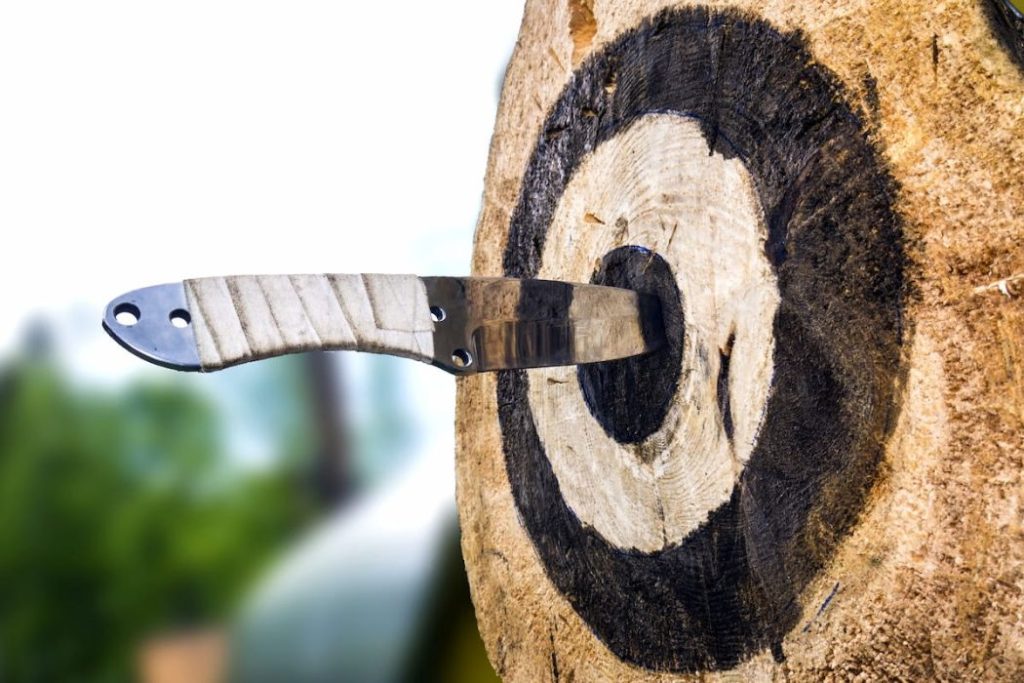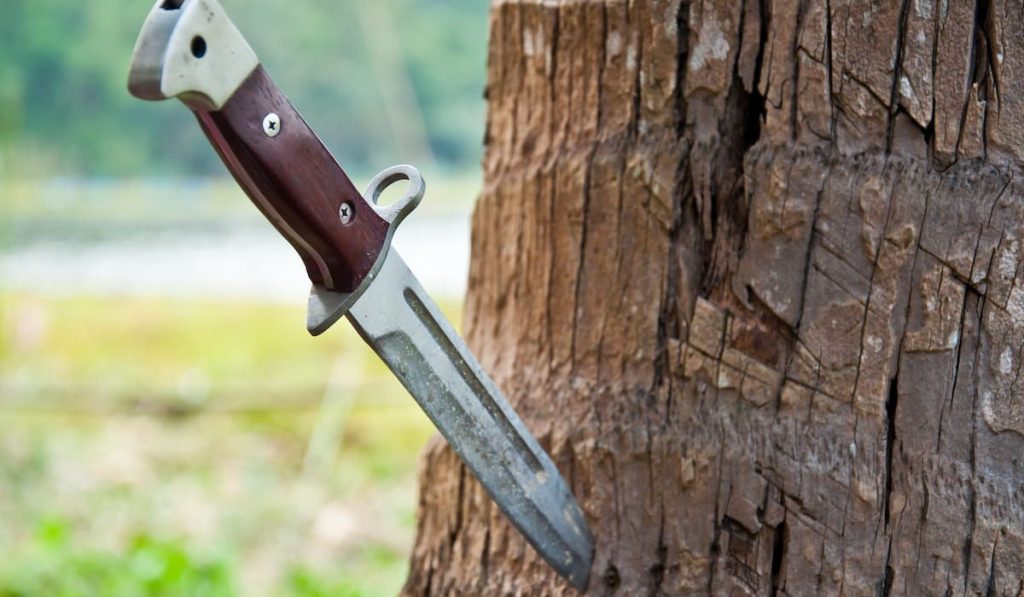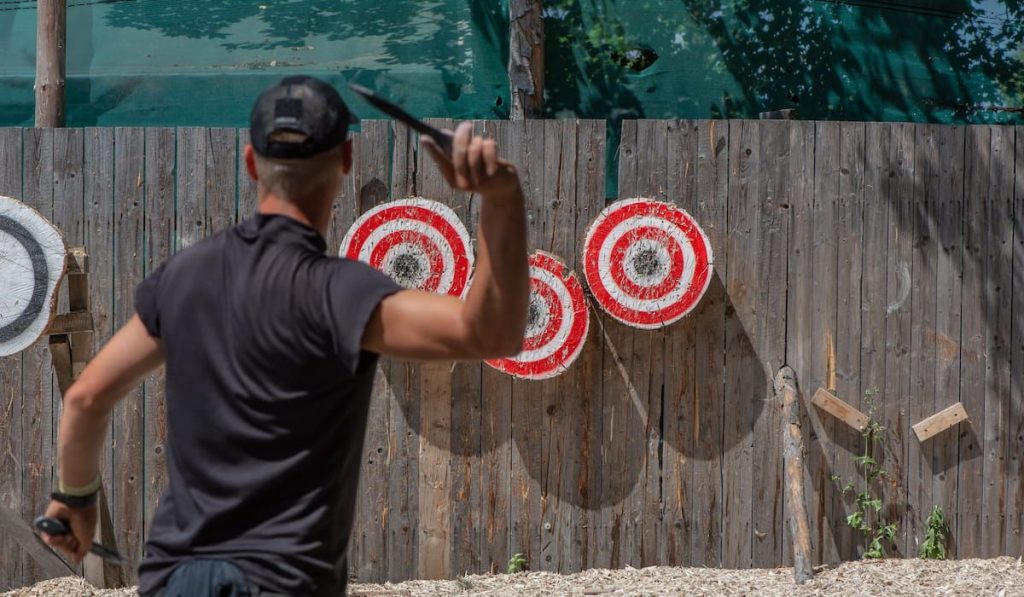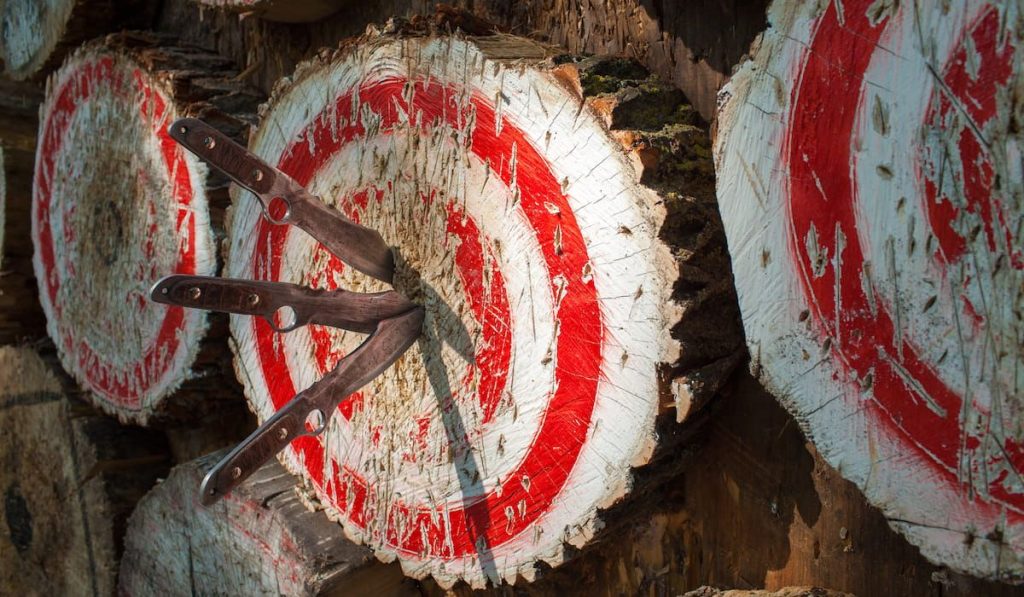If you’ve watched a whole season of any ‘Got Talent’ show, you know what this exciting hobby is about.
This spectacular sport became popular in the 19th century by circus performers. They would attempt hitting a bullseye or avoid striking their assistant strapped onto a rotating wheel or standing in front of a wooden target.
However, it started way before that when men used sticks to strike birds and animals for food. It’s hard to say when and where exactly actual knife throwing began, but some sources claim that it started in Africa around 1000 AD for hunting and warfare. Particularly in Sudan, Congo, and Gabon where men threw blades to injure the legs of animals they were hunting or men they were fighting.
These throwing blades came in all shapes and sizes. Some looked like sickles, others were curved, while some resembled police batons. European collectors gathered these blades and as a result, British and American Museums display an extensive collection of old throwing knives from Africa.
Native American tribes are said to have also adopted knife throwing during wartime. At some point, this became an ineffective defense tool as throwing a blade meant losing it. They had also started throwing as a pass time activity when they weren’t fighting.
This is where knife throwing most likely developed into a fun hobby and later a competitive activity to determine who had the best skill and accuracy.

Why Target Knife Throwing is a Good Hobby
Your loved ones might not understand why you enjoy knife throwing, but don’t let that deter you. This exciting hobby is a cool way to learn something new and have fun.
If you’re still on the fence about whether you should pick up a throwing knife, here’s why you should:
Affordable
One of the questions that cross your mind when considering a new hobby is how much it will cost. With knife throwing, you don’t have to worry about expensive tools and gear.
You can get a set of three throwing knives dirt cheap. Always check for reviews so that you’re not buying poor quality.
You’ll spend very little to make a target stand for your backyard with blocks of wood.
Taking Part in History
If knife throwing appeals to you, you’re probably interested in history too. This prehistoric activity tells the story of how Africans and Native Americans started hunting and engaging in war way back.
Relive this history with some modern throwing knives and a homemade target in your backyard.
Relaxing and Stress Relieving
Knife throwing sounds like an intense activity when you first hear of it, but it’s not. It’s a fun and relaxing hobby like other target sports, for example, archery and darts.
If you start out feeling stressed or a bit upset, you’ll feel so relaxed afterward. The great thing about this sport is that it will keep you occupied for several hours a day.
A Competitive Sport
Knife throwing can be more than just a backyard activity if you like. You can make it even more exciting by taking part in competitions in your area or around the country.
Knife throwing organizations like the American Knife Throwers Alliance, guide individuals, and groups that are interested in throwing competitively. The organization will give you the required information and dates of events and competitions happening in your area.
Sociable Activity
Knife throwing is fun even on your own but if you love being in the company of other throwers, it can also be an engaging and sociable activity.
You can teach beginners how to throw. Additionally, you get to network with like-minded individuals and make new friends by joining local competitions.
Moreover, you also attend informal get-togethers or host them in your backyard.
Builds Concentration and Coordination
Throwing requires you to focus so that you can hit a target or strike a bullseye. Sometimes there’ll be distractions and interruptions, especially if you’re throwing outdoors.
With consistent practice, you’ll become a better thrower because your level of concentration and coordination will improve over time.
Provides Moderate Exercise
Unlike other hobbies that don’t require you to move your body completely, knife throwing provides moderate exercise throughout the whole body.
Your shoulders and triceps are exercised when you’re throwing the knife. When you make bad throws, you’ll have to walk back and forth and bend to pick them up. This activity will work on the rest of your body.
Experience with Variety of Knives
The availability of various tools means that every thrower has a knife they prefer. You can use different sizes and weights depending on whether you’re a novice or an expert.
Some knife throwing competitions have specific rules on what types or sizes of knives they accept. This exposes you to various knives.

Who Can Do It?
The typical knife thrower is hard to describe because it’s an activity for everyone. Whether you’re young, old, female, male, you can throw knives.
Don’t let those martial arts movies fool you into thinking you have to be a black belt ninja.
Children and Teenagers
Many knife throwing ranges will not accept children below 12 years old. However, some parents claim that they’ve introduced their children as young as 4 and 5 to the sport in their backyard.
Throwers under 18 must go to the range with an adult to ensure safety guidelines are followed.
Young throwers should be able to throw knives 200g or heavier as lighter ones will bounce off the target and may cause injury.
Children and teenagers can engage in knife throwing as part of birthday and party activities to make it more fun. Adults should be on hand to offer guidance and safety tips.
Adults
Adults of any age can practice knife throwing. As long as they can throw a knife no less than 200 grams and follow safety guidelines.
This is a fun social activity to engage in after work and on weekends with friends and family. If you have a safe indoor space, you can practice at night too.
What Equipment Do You Need?
Success at any hobby or sport requires using the right tools.
The great thing about knife throwing is you don’t need a bunch of equipment. However, it’s important to acquire the right ones so that you’re effective and out of danger.
Throwing Knives
For this sport, not any ordinary knife will work. Throwing knives are designed and weighted specifically to effectively hit a target. Using any type of knife will be a danger to you and others around you.
The knife must weigh at least 200 grams. Anything lighter will be unstable in flight. There are three basic types of throwing knives you should know about:
Blade-Heavy Throwing Knife
This knife is heavier in the blade than the handle. Sounds confusing, right? This type of throwing knife is highly recommended for beginners because they are stable in flight and easier to throw. Hold the lighter end (handle) and throw the heavier end (blade) first.
Handle-Heavy Throwing Knife
This throwing knife has a heavier handle. It will require you to hold the lighter end (the blade) and throw the handle first. You’ll start using this one when you get a grip on the sport because it takes time to get used to holding the blade.
Balanced Throwing Knife
The above two knives are each heavy on one end, making them unbalanced. Balanced throw knives have a middle center of gravity making it easy to throw from any end. These knives offer more predictable rotations and flexibility but aren’t ideal for most beginners.
Target
You’ll also need a target to strike with your throwing knife. Keep in mind that trees are not a proper target. Throwing at them will eventually destroy them and your knives. Also, with their cylindrical shape, the knives will be bouncing back in all directions.
If you’re into crafting and DIY, you can easily make your targets with planks of wood and round tree slices. Alternatively, you can buy targets and target boards .
Other requirements include:
Sheath
Keep your knife safely in a sheath when you’re not throwing or if it’s not yet your turn on a throwing range. You can tie a throwing knife leg sheath around your leg that can take up to 6 knives. This saves you the time and energy to walk back and forth to pick up the same knife each time. Alternatively, you can use a throwing knife shoulder holster which usually holds about three knives at once.
Comfortable Clothing
Make sure you’re wearing comfortable clothing that does not restrict your movement in any way. Avoid wearing hooded clothing as you may not be able to see who’s around you. Ensure that you have on full-length trousers just in case the knife bounces off the target.
Closed Shoes
Your shoes must be closed all around. There are scenarios where a thrower accidentally drops a throwing knife that heads straight for the toes. The knife might not be sharpened, but the tip is pointy and can hurt your toes. Trainers are the most ideal shoes for knife throwing. Not only do they protect your feet but are also comfortable to walk in to and fro to pick up your knives.

What You Need to Know
We can’t say that you need special skills to start knife throwing. It’s one of those amazing hobbies that you can start without knowing a thing about it. However, you will develop those skills as you keep practicing and this will take you to competitive levels if you’re interested. Let’s look at a couple of important guidelines for getting it right.
Safety
For any thrower, beginner, or expert, your safety and that of others is the most important factor to consider with this hobby. The guidelines are quite easy to understand and follow even for young knife throwers. A few safety tips include:
- Don’t throw at people or pets, not even as a joke.
- Don’t throw barefoot
- Dress appropriately
- Don’t practice in an area with many children running around
- Set your target far from anyone’s reach. If it’s a public area with a chance of passers-by, let the people around you know.
- Be keen about your surroundings and watch out for bouncing knives.
Choose the Right Knife
It’s important to choose the appropriate knife for your practice as it will affect how your skill and techniques improve. The best type for beginners is the blade-heavy throwing knife. Not all of them are equal because many brands make them differently. Do your research to find out which ones are of good quality and yet affordable. You can easily find them online and through referrals from friends.
Proper stance
Similar to other sports, stance or body posture is important. First of all, you must be relaxed. If your body is tense, try to relax before throwing. The basic stance for this hobby has the left foot in front of the right with both knees slightly bent. The space between the left and the right foot is about two actual feet. With your right arm, swing the knife behind your head and then forward to strike the target.
Accuracy
Knife throwing requires you to accurately strike your target. Don’t put too much pressure on yourself though. It takes hard work, practice, and trying out different techniques for you to hit your target accurately. You can start by throwing closer to your target then moving further as you get better. In the meantime, have fun with it.
Consistency
If you want to get good at this, you must be consistent. If you’re on and off with knife throwing, it will take you longer to hit your targets. Keep practicing regularly and aim at hitting your target more times than not hitting it. The best ratio to aim for is hitting 8 times out of 10. Don’t give up until you’re able to hit 10 out of 10.

Where Can You Learn Target Knife Throwing?
You can learn knife throwing through private or group lessons hosted by knife throwing ranges or individuals who hire a space to teach in your area. Simply search on the internet for ‘knife-throwing classes near me’.
The sessions take place indoors or outdoors depending on the available facility, weather, and time of day. Typically, instructors provide the throwing knives to make sure all the equipment is safe. All you need to do is show up dressed comfortably with closed-toe shoes and ready to learn and have fun.
You can also learn target knife throwing online through tutorials and books. Some instructors can also teach you via Skype or Zoom.
Where Can You Practice?
At Home
You can safely practice at home in your backyard. Simply make or buy a target and place it in your back yard at an appropriate distance. Make sure no pets or children are walking around while you throw. Knives tend to bounce back so ensure the area is clear of fragile property like glass furniture.
If you don’t have space inside or the weather isn’t perfect, take this fun inside. You can set up several layers of cardboard as a target. Knife throwing indoors creates more chances of bouncing knives. However, you won’t lose any knives and your neighbors won’t be disturbed. The best room for indoor practice would be an empty garage or basement lined with carpet from top to bottom.
Throwing Range
A throwing range is ideal because it is designated for that specific purpose. If everyone knows what happens there, the chance of random people walking by is low making it a safe zone. Throwing ranges also allow a limited number of people to throw at any one time, so it’s quite organized.
Throwing knives outdoors is awesome but in case it starts raining or your only free time to shoot is late in the evening, what happens? Well, some ranges have indoor facilities in the same location but those that do not may have to arrange with an institution like a university that has large indoor spaces to set up a throwing range.
Go Throw Some Knives!
As we’ve established, target knife throwing is a fun and exciting hobby. Hopefully, any misconceptions you may have had about it are now clear.
Some people won’t understand it but don’t get discouraged. There’s nothing more awesome than hearing the tip of your knife striking a target yards away. It will feel strange at first, just like learning to ride a bike, kicking a ball, or holding a bat for the first time.
Be kind to yourself and keep in mind that your body needs time to get used to any new activity. There’s no pressure to be perfect, that’s why you can practice in your backyard or with friends at the range.
However, if you want to compete in the sport, you’ll need regular and consistent practice. Thankfully, you can learn everything you need to know online.





